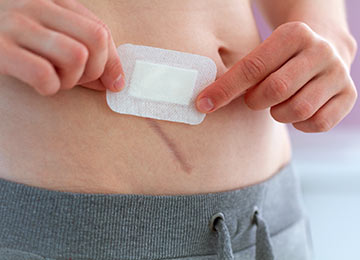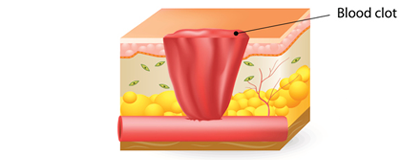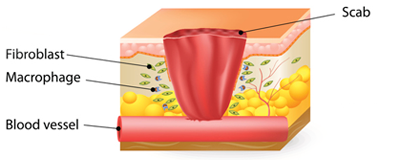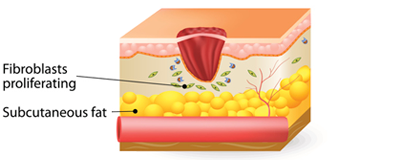
At some point during your hernia repair journey, you may ask some of the following questions: How long does the hernia surgery wound take to heal up? Can I damage my healing wound? Why can’t I play sports? Why must I avoid heavy lifting?
We know these concerns are on your mind, and we’re here to provide some clear, reassuring answers. We believe it’s helpful to understand a bit more about what’s happening inside your body during the hernia wound healing process so that you allow time for the repair to strengthen.

This phase involves stopping any bleeding by sealing the leaky edges of the wound. When platelet cells from the blood vessels encounter collagen fibres (outside blood vessels), it sets off a coagulation cascade. This clot then forms a stable plug of cells by depositing fibrin – the scab.
This is the body’s emergency response to tissue injury (a surgical wound). Leaving the wound covered for the first week, or so, quickens the healing process and reduces chances of infection.

Once the plug is stable, small capillary blood vessels open bringing more oxygen to the wound.
The wound attracts white blood cells (neutrophils) to the scene which mature into macrophages. Macrophages clean up the wound, removing dead cells and any contaminants.
The wound is filled with oxygenated fluid and cells, becoming swollen, red, warm, and tender. Although this can be uncomfortable, these are normal symptoms of hernia wound healing and should be left alone.

The cells that are brought in start to multiply and mature to further the healing.
The fibrin used to make the plug stable attracts fibroblasts. Fibroblasts secrete procollagen, and procollagen bridges the gap between the 2 sides of a wound.
The procollagen joins together to make collagen fibrils that are short and laid down in a haphazard fashion filling in the gap.
This is essential to ensure that the repair heals and strengthens.

These collagen fibrils are building blocks that will join together to form long collagen fibres.
During this phase of healing, gently exercising, moving and stretching the scar over time improves its flexibility and long-term comfort.
Myofibroblasts are another type of specialised cell that come from fibroblasts (remember that thing from Phase 3 that secrets procollagen?). Myofibroblasts help to contract the scarring tissue and form elastic cross-bridges making the scar neater, finer, and stronger still.
Our Hernia Rehabilitation Exercises are particularly beneficial during this phase of wound healing.
These phases are overlapping. Each phase of wound healing can be delayed or sped up by altering the environment the wound exists in. For example:
Our Hernia Recovery Programme helps improve how your wound heals through the use of:
Hernia supports not only aid wound healing and scar tissue formation, they also help you be more confident returning to activity. Increased activity helps improve wound healing and the comfort of your scar, as well as reduce bruising after hernia surgery.
If using groin hernia pants/briefs (as opposed to the abdominal belt/wrap), use with the pad inserted pre-surgery and for the first 48 hours post-surgery. From day 3 post-surgery, wear with the pad removed.
The supports we sell have been tested and recommended by past patients. You can buy these supports directly from us on our shop.
We also provide extensive guidance on how to get the best fit if you want to purchase supports elsewhere.
Our Hernia Rehabilitation Exercises are specially designed to help you get back to activity safely, restrengthen your repair and improve the long-term comfort of your scar.
During the initial 1-2 week post-surgery period, the exercises help boost blood flow to your repair and improve wound healing.
While your scar remodels (from 4-6 weeks until 6 months post-surgery) the exercises help influence a more flexible and more comfortable repair.
Purchase these from our Hernia Recovery Programme Shop.
If buying a self-funded surgery package with us, these exercises are included in the cost.
When you book surgery with us, you will also get access to our valuable advice leaflet on what to expect after surgery including how to massage your wound for a more comfortable scar.
The wound changes shape and colour through the 4 phases of wound healing.
Research* shows that it takes 6-8 weeks for a wound to get to about 80% strength. The final wound does not get much stronger than this.
*published in Plastic and Reconstructive Surgery—Global Open, 2013 (doi:10.1097/GOX.0b013e31828ff9f4)
